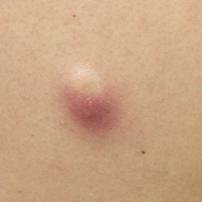Removal of atheroma

Clinical symptoms
A pulp tumor, or atheroma, is a node filled with sebum located directly under the skin. It consists of a connective tissue capsule and the foul-smelling, mushy sebum produced by the sebaceous gland. The first step in its formation is the blockage of the outlet of the gland, which causes the sebum produced in it to accumulate which leads to the enlargement of the sebaceous gland.
In the vast majority of cases, it occurs on the face, scalp, or back. Its diameter can range from a few millimeters to several centimeters. Atheroma basically causes an aesthetic problem. In addition, it sometimes becomes infected, in which case the nodule swells, becomes inflamed, warm, exudates, and causes a painful and tense feeling. If the inflamed atheroma is not treated an abscess forms which means a long-lasting exuding wound. Unfortunately, this leads to scarring.
At our private appointment, we perform atheroma removal with a carbon dioxide laser
I am waiting for you with my 31 years of experience
Surgical reasons
Removal of the pulp tumor (atheroma) is justified for several reasons. Removal at rest is done for aesthetic reasons or to prevent inflammation. The third reason is the treatment and removal of the inflamed atheroma (abscess).
How does the carbon dioxide laser work in the case of atheroma removal?
The light of the carbon dioxide laser is absorbed in the tissue water, in the meantime heat develops and the cells boil and explode. In the case of atheroma it is used as a "sharp knife" for fine cutting.
What are the advantages of carbon dioxide laser at the atheroma removal?
Based on our many years of experience the use of the carbon dioxide laser provides several very important advantages both for the patient and the doctor too.
- It is absorbed in 0,1 mm depth in the skin so its effect can be controlled with great accuracy.
- There is no need to make suture.
- he operation is quick so the burden for you is minimal.
- The laser light obstructs the small blood and lymphatic vessels so there are no bleeding during the operation.
- You can very rarely feel pain after the operation.
- The laser light destroys the pathogens on the surface of the skin so the wound surface will be sterile.
- The wound heals quickly and with cosmetically good results.
- You can do the simple bandage exchange at home based on the written paper about it.
How to remove atheroma with a carbon dioxide laser?
During the operation in the resting state after local anesthesia an incision is made with a carbon dioxide laser above the atheroma. Then we remove the atheroma together with the capsule than we unites the wound is. The surgery time depends on the size or it takes 10-15 minutes depending on the location. After healing an aesthetically pleasing, line-like scar remains.
Treatment and removal of inflamed atheroma: in this case we decide about the method of treatment based on several aspects (size, location, degree of inflammation). Generally, at the beginning it means the using of a steam binding. As a result of steaming the inflammation collects and an opening forms, through which the pus can drain spontaneously, or it can be squeezed out after opening. If the circumstances allow we try to remove the atheroma together with ist capsule but this is not always possible due to the inflammatory environment. We do not close the wound which serves the purpose of allowing the inflammatory exudate to drain out. If the case cannot be removed, the atheroma may recur.
What do you need to do after the removal of an atheroma with a carbon dioxide laser?
After the operation of the atheroma in a dormant state, the applied special bandage must be kept for a week and the incision will heal during this time. After a week we remove the sticking used to unite the incision. We provide detailed written information about the dressing change required after surgery for inflamed atheroma. The wound is slowly lifted from below and heals in 2-3 weeks with secondary wound healing.
What discomforts can you experience after the removal of an atheroma with a carbon dioxide laser?
Complications can develop even after the most careful medical intervention. Early complications (bleeding, inflammation) can be treated easily. A late complication is the recurrence of the atheroma which occurs when the atheroma can not removed together with the capsule due to inflammation.
When do we not remove an atheroma with a carbon dioxide laser?
Unrealistic expectations from the patient.
When do we remove an atheroma with a carbon dioxide laser only after careful consideration?
Pregnancy, diabetes.
Visit: 33 000 HUF
Surgical fee: removal of the first atheroma: 40 000 HUF, removal of additional atheroma: 25 000 HUF/ piece

